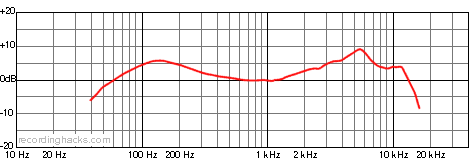Today I was recording guitar (surprise!) and I decided to try something a little different.
My usual go-to combination is a 57 paired with either a Royer or Rode ribbon mic. The Rode actually has a better high end than the 121, but both are great. However, there are times you want something different.
I've always liked the Sennheiser MD421 for guitar cabs, but its midrange feels a bit thinner, though its high frequencies are much more extended than most dynamics (the lower mids even measure thinner, depending on placement). I also like the SM57 and Audix i5 alone, but their midranges are a little hot.
I've never been huge on condenser mics with guitar amps. I know some players love them, but...I dunno. I find the whole business too crispy-critters.
Sometimes you want a dynamic mic, not a ribbon or condenser, that is a bit more natural sounding with certain amps. But dynamic instrument mics aren't really made to be all that natural sounding, they do "a thing." So...I went outside the box.
Sennheiser makes a nice vocal mic for live work called the e935. The published frequency response specs look pretty flat out to about 10K, far beyond the range of guitar amps, and you can really focus on a particular area of the speaker cone. I thought I'd try it on guitar amps.
What a pleasant surprise -- it's really good-sounding on guitar amps - it's very warm and natural. It's easy to overload the mic preamp, though, so you have to set levels a bit more carefully than you would with, say, a 57.
But...it's very natural sounding. I really like it, and it proves once again that you just never know what's going to work until you put up a mic.
My usual go-to combination is a 57 paired with either a Royer or Rode ribbon mic. The Rode actually has a better high end than the 121, but both are great. However, there are times you want something different.
I've always liked the Sennheiser MD421 for guitar cabs, but its midrange feels a bit thinner, though its high frequencies are much more extended than most dynamics (the lower mids even measure thinner, depending on placement). I also like the SM57 and Audix i5 alone, but their midranges are a little hot.
I've never been huge on condenser mics with guitar amps. I know some players love them, but...I dunno. I find the whole business too crispy-critters.
Sometimes you want a dynamic mic, not a ribbon or condenser, that is a bit more natural sounding with certain amps. But dynamic instrument mics aren't really made to be all that natural sounding, they do "a thing." So...I went outside the box.
Sennheiser makes a nice vocal mic for live work called the e935. The published frequency response specs look pretty flat out to about 10K, far beyond the range of guitar amps, and you can really focus on a particular area of the speaker cone. I thought I'd try it on guitar amps.
What a pleasant surprise -- it's really good-sounding on guitar amps - it's very warm and natural. It's easy to overload the mic preamp, though, so you have to set levels a bit more carefully than you would with, say, a 57.
But...it's very natural sounding. I really like it, and it proves once again that you just never know what's going to work until you put up a mic.
Last edited:







